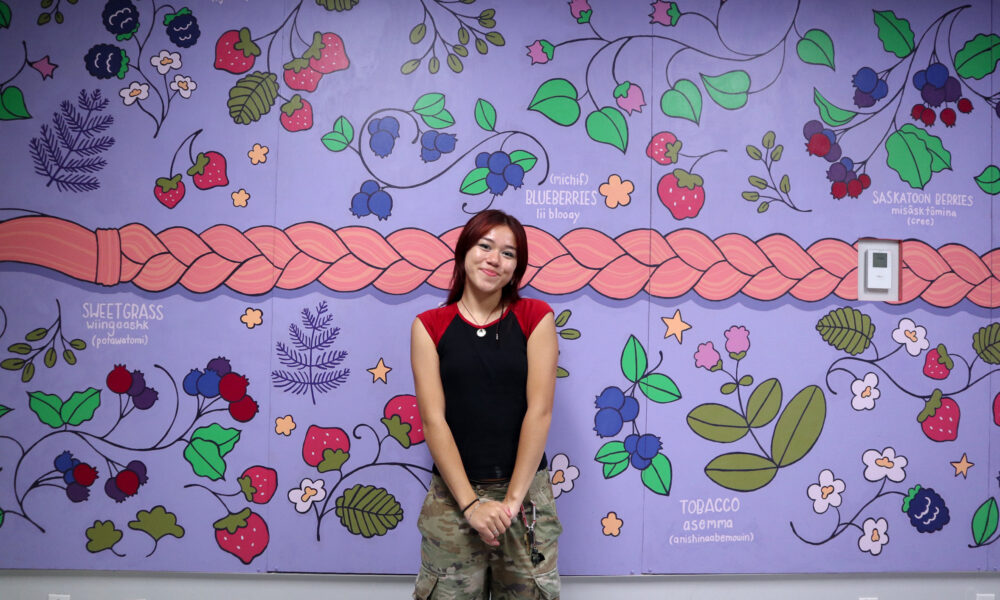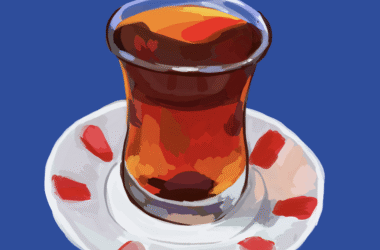A braid of sweetgrass winds across a purple backdrop in the University Centre’s flex space across from Gerts Student Bar. The mural, entitled “Interwoven,” represents more than vibrant artistic expression—it’s a deliberate effort to establish Indigenous presence in one of McGill’s most frequented student spaces. Zoe Gesaset-Gloqowej Lee, the Chinese-Mi’kmaq artist behind the installation, collaborated with Student’s Society of McGill University (SSMU) Indigenous Affairs Commissioner Delanie Havevrock to bring the project to fruition.
The design is inspired by Lee’s featured article in The Tribune, “A Minor Is Not Enough,” which calls on McGill to expand its undersupported Indigenous studies minor into a durable and meaningful program. The featured art installation centers on strands of sweetgrass—a plant used both ceremonially and medicinally across many Indigenous communities—braided together.
“We wanted to include a design element that connects all of the visual motifs both in practice and in principle,” Lee explained in an interview with The Tribune. “The sweetgrass ties the whole mural together, being language, community, traditional practices, people, land, and the distribution of those things.”
Alongside the sweetgrass, the art installation is filled with culturally significant plants like Saskatoon berries, blackberries, and cedar. These elements are labeled in different Indigenous languages, including “Shá:yehse” for blackberries in Kanien’kéha and “Gasgusi” for cedar in Mi’gmaq. Lee deliberately chose elements that reflect the interconnectedness of Indigenous practices while respecting the distinct traditions of different communities.
“We wanted to highlight the diversity across Canada, while also not watering it down into something that was just like a greeting card,” Lee explained, describing the thoughtful approach taken to honour distinct Indigenous traditions throughout the art installation.
The creation process spanned from Oct. 2024 to May 2025, involving extensive community dialogue at First People’s House and collaboration with MU, a Montreal-based mural company, which she worked alongside with for two and a half weeks to bring her vision to life.
Lee emphasized the collaborative nature of the project. “There’s just been so much input from everywhere. It’s really a community-based initiative.”
Lee noted the contrast between individual support from community members like Indigenous Affairs Commissioner Havevrock and institutional barriers from McGill’s administration.
“There really wasn’t very much support in terms of the administration and the institution,” Lee observed. “It really comes down to the individuals who want to make this happen.”
For Lee, visual representation matters deeply, especially at a university that lacks a visual arts program. “I think visual design really changes a space,” she said. “This is a way to highlight not only the arts, but also Indigenous art and Indigenous creation.”
The mural serves an educational purpose beyond aesthetics. Lee hopes viewers will reflect on “the relationship between land, art, community, and language” while learning about Indigenous linguistic diversity. The piece explores the interconnectedness of different Indigenous communities through shared practices while celebrating distinct cultural expressions.
“It’s a call for reflection and for learning, because there’s all these different languages and all these different words that most people have probably never seen before,” Lee explained.
With the “Interwoven” art expo and concert planned for Sept. 23, Lee sees art as a powerful tool for reconciliation and education, with the potential to bridge gaps between communities. “It is accessible in a way that words and language aren’t […] art is so fundamental to so many different cultures, it’s not just something that one person has authority over.”
This accessibility makes art uniquely suited for fostering understanding in ways that transcend linguistic barriers.
“Art says so many things that words sometimes can’t,” Lee said. “I want people to see my mural, be inspired to combine their passions, and say something and be visible.”
The mural represents one step toward meaningful Indigenous presence at McGill, though Lee emphasizes that while visibility and acknowledgment alone are important, they are not sufficient. The success of “Interwoven” stands proudly as a call for sustained institutional commitment at McGill to make such collaborations with Indigenous students and communities the norm, rather than the exception.
Artist Zoe Gesaset-Gloqowej Lee is a Design Editor at The Tribune. She was not involved in the editing or publication of this article.







